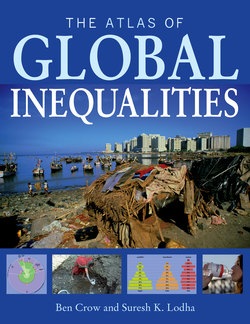Читать книгу The Atlas of Global Inequalities - Ben Crow - Страница 12
На сайте Литреса книга снята с продажи.
Оглавлениеnotwithstanding (Agarwal, Humphries and Robeyns 2005: 8-9), has helped revitalize the study of social change, and facilitated analysis and action to recognize and mitigate multidimensional inequality. There is, as Therborn notes, a need to make this analytical approach more accessible and useful for empirical research. Ideas of entitlement, capability, functionings and freedoms are not easily understood or measured. They provide a way of disaggregating human achievements, the lives we want, and the complex social and physical processes that produce them. In this atlas, the analytical approach helps to illuminate the multiple dimensions of inequality, and an exploration of current understanding of the social dynamics of each. To make sense of the many dimensions of inequality, the atlas is structured around a set of categories based on terms in common usage. Human Development Index In 1990, the UN Development Program, one of the UN’s less influential agencies, engaged one of the most powerful (the World Bank) in a discussion about how to represent human achievement. At stake was whether progress should be measured by the proliferation of goods, or by the length and quality of people’s lives. The UNDP, drawing partly on ideas from Amartya Sen, proposed measuring human achievement with the Human Development Index, an aggregate measure combining life expectancy, literacy and an improved indicator of productivity (GDP per capita at Purchasing Power Parity – see page 118 for definition). No single indicator is adequate to represent the multiple dimensions of global inequality, but the HDI has opened up discussion of social priorities. The HDI reveals the importance of action, usually governmental or collective, through programs that redistribute, include, and protect the interests of the disadvantaged. The diagram (right) demonstrates that there is not necessarily a direct correlation between national income and human development. Saudi Arabia, for example, is famously rich from oil royalties, but achieves less for its citizens in terms of life expectancy and literacy than does Cuba, with one-third the GDP per capita. Countries with similar national incomes per capita, such as Armenia, Egypt, and Angola, have HDI scores that are very different. This reinforces the point that government action for the disadvantaged matters. On the whole, however, industrialized areas of North America and Europe tend to have a high HDI, while non-industrialized, developing, areas of Africa and South America have lower HDI, as is evident from the map on pages 10–11. Social action in countries with low levels of income can raise their HDI scores to match the scores of countries with higher income primarily by reducing inequality and increasing the efficacy of spending on health and education. Although most countries’ HDI score has been increasing, inequalities between rural and urban areas persist, especially in those countries, such as China, where the national economy is booming. The rural population in every province of China experiences worse living conditions, on average, than those registered as urban (which
12
